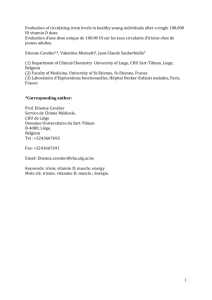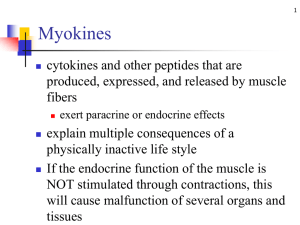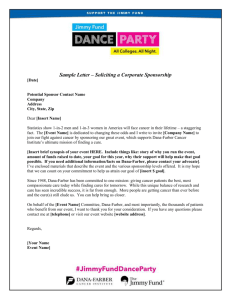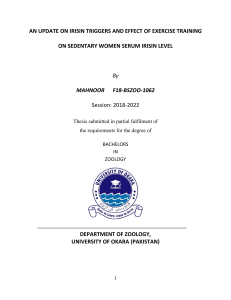Media Release
advertisement
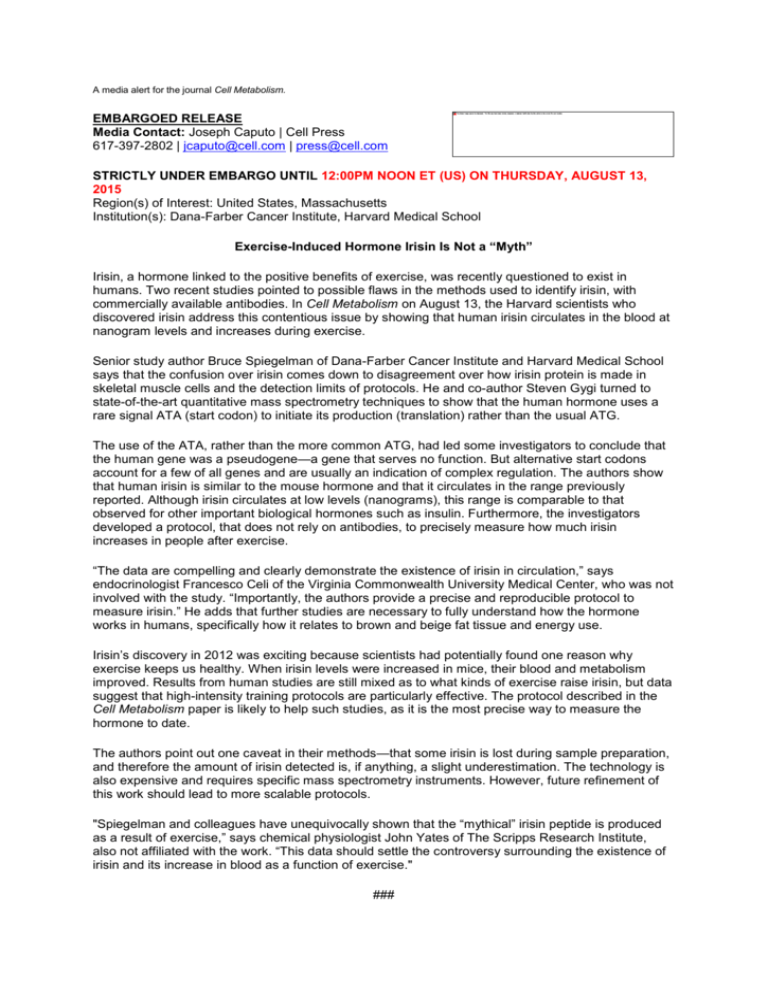
A media alert for the journal Cell Metabolism. EMBARGOED RELEASE Media Contact: Joseph Caputo | Cell Press 617-397-2802 | jcaputo@cell.com | press@cell.com STRICTLY UNDER EMBARGO UNTIL 12:00PM NOON ET (US) ON THURSDAY, AUGUST 13, 2015 Region(s) of Interest: United States, Massachusetts Institution(s): Dana-Farber Cancer Institute, Harvard Medical School Exercise-Induced Hormone Irisin Is Not a “Myth” Irisin, a hormone linked to the positive benefits of exercise, was recently questioned to exist in humans. Two recent studies pointed to possible flaws in the methods used to identify irisin, with commercially available antibodies. In Cell Metabolism on August 13, the Harvard scientists who discovered irisin address this contentious issue by showing that human irisin circulates in the blood at nanogram levels and increases during exercise. Senior study author Bruce Spiegelman of Dana-Farber Cancer Institute and Harvard Medical School says that the confusion over irisin comes down to disagreement over how irisin protein is made in skeletal muscle cells and the detection limits of protocols. He and co-author Steven Gygi turned to state-of-the-art quantitative mass spectrometry techniques to show that the human hormone uses a rare signal ATA (start codon) to initiate its production (translation) rather than the usual ATG. The use of the ATA, rather than the more common ATG, had led some investigators to conclude that the human gene was a pseudogene—a gene that serves no function. But alternative start codons account for a few of all genes and are usually an indication of complex regulation. The authors show that human irisin is similar to the mouse hormone and that it circulates in the range previously reported. Although irisin circulates at low levels (nanograms), this range is comparable to that observed for other important biological hormones such as insulin. Furthermore, the investigators developed a protocol, that does not rely on antibodies, to precisely measure how much irisin increases in people after exercise. “The data are compelling and clearly demonstrate the existence of irisin in circulation,” says endocrinologist Francesco Celi of the Virginia Commonwealth University Medical Center, who was not involved with the study. “Importantly, the authors provide a precise and reproducible protocol to measure irisin.” He adds that further studies are necessary to fully understand how the hormone works in humans, specifically how it relates to brown and beige fat tissue and energy use. Irisin’s discovery in 2012 was exciting because scientists had potentially found one reason why exercise keeps us healthy. When irisin levels were increased in mice, their blood and metabolism improved. Results from human studies are still mixed as to what kinds of exercise raise irisin, but data suggest that high-intensity training protocols are particularly effective. The protocol described in the Cell Metabolism paper is likely to help such studies, as it is the most precise way to measure the hormone to date. The authors point out one caveat in their methods—that some irisin is lost during sample preparation, and therefore the amount of irisin detected is, if anything, a slight underestimation. The technology is also expensive and requires specific mass spectrometry instruments. However, future refinement of this work should lead to more scalable protocols. "Spiegelman and colleagues have unequivocally shown that the “mythical” irisin peptide is produced as a result of exercise,” says chemical physiologist John Yates of The Scripps Research Institute, also not affiliated with the work. “This data should settle the controversy surrounding the existence of irisin and its increase in blood as a function of exercise." ### This work is funded by the JPB Foundation and the National Institutes of Health. Cell Metabolism, Jedrychowski et al.: “Detection and Quantitation of Circulating Human Irisin by Tandem Mass Spectrometry” http://dx.doi.org/10.1016/j.cmet.2015.08.001 In online coverage, please mention the journal Cell Metabolism and link to the paper at http://www.cell.com/cell-metabolism/abstract/S1550-4131(15)00392-7 Related Files: This Dropbox contains: https://www.dropbox.com/sh/x8e7c8vlt36ltdg/AAAb_OLe8PbMMq1e6Y1p733a?dl=0 A PDF of the paper proof. Author Contact: Bruce M. Spiegelman, PhD Dana-Farber Cancer Institute, Harvard Medical School 617-632-3567 bruce_spiegelman@dfci.harvard.edu Outside Expert Contacts: To schedule an interview with Dr. Francesco S. Celi, MD, MHSc, of Virginia Commonwealth University Health System, please contact the NIDDK media office at: niddkmedia@niddk.nih.gov Dr. John Yates, PhD, of The Scripps Research Institute, can be reached at: jyates@scripps.edu. Media Contact: Richard Saltus Dana-Farber Cancer Institute 617-632-5643 Richard_Saltus@dfci.harvard.edu
